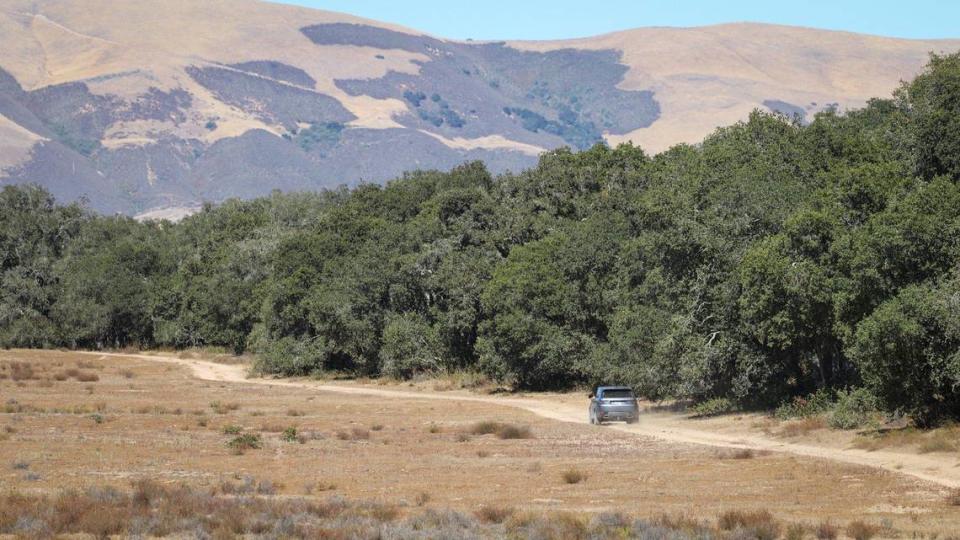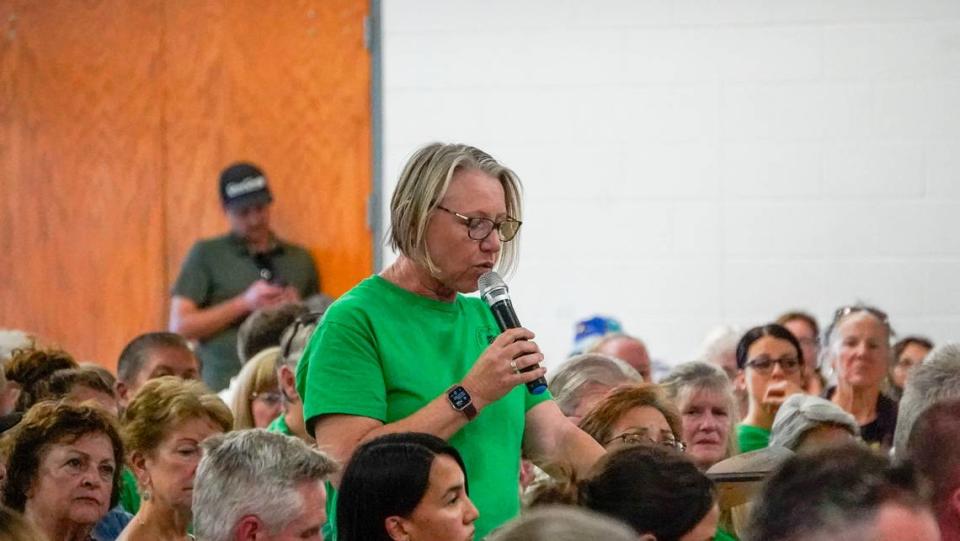Critics pack meeting on SLO County housing project: ’Why cut down 3,000 oak trees?’
More than 200 people made their thoughts on a proposed Nipomo housing development known during a town hall meeting Monday evening, with most attendees voicing vocal opposition to the project.
Developer Nick Tompkins attended the meeting, hosted by the South County Advisory Council at Nipomo High School, to discuss changes to the proposed Dana Reserve housing development ahead of the project’s final environmental impact report.
Tompkins, owner of development company NKT Commercial, presented the final version of the project, which incorporated feedback from local governments and residents after a lengthy review process.
“Getting a project like Dana Reserve approved in today’s regulatory process is much akin to going to the dentist to have a tooth pulled,” Tompkins said. “The cost is worth the time, the capital and the effort as the need — especially today — is so great.”
At Monday’s meeting, many Nipomo residents expressed concern about the 1,318-home project located near Willow Road and Highway 101 and its impacts to the local ecosystem. Others said it will provide much-needed workforce housing.
Here’s how the project changed — and what Nipomo residents had to say about it ahead of its final environmental impact report.
How have plans for Nipomo housing development changed?
With a final environmental impact report for the Dana Reserve project on the horizon, Tompkins presented an overview of the development in its most recent form.
The most recent form of the development features some modifications to meet the requests of neighbors.
The 288-acre project would consist of 1,318 units — 29 more units than the previous version of the project — spread across 10 neighborhoods, Tompkins said during the meeting.
Neighborhoods 1, 2, 10A and 10B are planned for the area nearest to the planned commercial center and flexible commercial zone bordering the west side of Highway 101, Tompkins said. All four would consist of mult-family housing of different types, Tompkins said.
People’s Self-Help Housing, a Central Coast nonprofit housing organization, will construct 104 homes in Neighborhoods 10A and 10B, while Neighborhood 1 and 2 will feature a total of 383 apartment-style townhomes, Tompkins said.
These townhomes would be the most affordable homes in the development, with the People’s Self-Help Housing units charging 30% of the residents’ incomes and rent in the dwellings in Neighborhoods 1 and 2 between $600 and $1,200 a month, the developer said.
Neighborhood 3, consisting of 124 two-story homes built in “four-packs” on smaller lots, would be the next most affordable part of the development, Tompkins said. It’s the only so-called cluster lot proposed for the property.
A 75-foot buffer was added to the south side of Neighborhood 3 to separate the Dana Reserve development from existing neighborhoods off of Sandydale Drive, Tompkins said.
Neighborhoods 4, 5 and 6, which would be located at the center of the development, would feature lot sizes between 4,000 and 5,000 square feet, and would consist of a total of 290 units.
Some single-family homes will have enough space on their lots for accessory dwelling units.
The number of ADUs, Tompkins said, could number as many as 154, though he said that adoption and usage of ADUs is a “complete dart throw.”

Units in Neighborhoods 1 through 6 are expected to retail at about $470,000 to $670,000 each, Tompkins said in November.
One new aspect of the plan is a matching down payment assistance program that would be administered by People’s Self-Help Housing, Tompkins said.
This program would use a $3.2 million donation to the Community Foundation of San Luis Obispo County to provide up to $32,000 in down payment assistance to buyers with demonstrated financial need, Tompkins said.
“If your life goes upside down and the housing market collapses, you never have to pay it back, and it doesn’t mean your credit or anything,” Tompkins told The Tribune on June 29 prior to the town hall meeting. “However, if you do sell your home and you haven’t been wiped out, and there’s dollars leftover, then you pay it back to the Community Foundation, and the idea behind that is then they can lend it out on other projects under the same scenario, not just here, but around the county.”
Another change concerns the highest-value homes in the development, found in Neighborhoods 7, 8 and 9, Tompkins said.
These homes would be constructed by Shea Homes, which built the Trilogy at Monarch Dunes development in Nipomo, and are expected to sit on lots between 4,500 and 10,000 square feet, costing between $1 million and $1.2 million, Tompkins said in November.
These homes are now restricted to home buyers over the age of 55, a decision Tompkins said was made to reduce impacts on local schools and vehicle miles traveled to and from the development, as older buyers are less likely to have children or use the roads at peak hours.
Infrastructure upgrades for water, fiber-optic internet and roadways are still planned should the project move forward, Tompkins said.
Other changes included adding 7.5 miles of equestrian trails to the project and converting the development’s proposed active park to a passive park to save on maintenance costs, Tompkins said.
Active parks typically require development and facilities for team activities, where passive parks take a low-development, open-space approach.

Supporters: SLO County businesses held back by lack of homes
Adam Verdin, owner of Old Juan’s Cantina in Oceano, was among the community members who attended Monday’s meeting to show support for the project.
Verdin’s family has owned the restaurant for 47 years, but began experiencing difficulties with rehiring employees when COVID-19 lockdown procedures started to scale back in early 2021, Verdin said.
That was largely because there isn’t enough housing in the area to support the staff, he said.
“We employ between 50 and 55 employees both full-time and part-time, and we have eight employees right now that live in Santa Maria or Orcutt that are traveling to Oceano for work,” Verdin told The Tribune during Monday’s meeting. “We’re just one business. I have to think there’s other businesses in similar positions.”
Verdin said Dana Reserve’s model of introducing more workforce and affordable housing was promising, even though the prices for the homes would still be competitive.
“I would think that for the success of our business, and other small businesses like ours, we need housing,” Verdin said.

Another industry that has been hurt by lack of housing in the Nipomo area is the hospital and medical sector, Arroyo Grande Community Hospital chief administrative officer Ken Dalebout said during Monday’s meeting.
Dalebout said the hospital systems closest to Nipomo have struggled to fill positions with quality staff.
Its not uncommon for physicians or medical professionals to turn down offers from Arroyo Grande Community Hospital and other Dignity Health locations due to the high cost of living in Nipomo, Dalebout said.
The economic forecast for this area is to increase population, and without adequate housing, we will not be able to sustain the health care system,” Dalebout said during the meeting. “Without adequate housing, we will not be able to recruit people to take care of the population.”
In addition to staffing problems, health outcomes tend to be better in regions with adequate housing, Dalebout said.
“There’s abundant research, and all of us in this room have lived the experience that there’s a direct relationship between having adequate housing and having healthy communities,” Dalebout said. “Where there is inadequate housing for a community, the residents have poor outcomes.”
High costs of living have already caused some local workers to reconsider whether Nipomo is feasible as a long-term place to live, other speakers said at the meeting.
After he and his wife got their degrees at Cal Poly, Clayton Carlson said they decided to settle down in Nipomo, hoping it would be more affordable than other San Luis Obispo County cities.
Carlson, an agriculture mechanics teacher at Nipomo High School, said he and his wife were long-term renters in Nipomo for several years. When the time came to look for a home they could purchase, he added, they couldn’t find any housing they considered affordable.
As a result, Carlson and his wife moved to Guadalupe, where housing costs are less severe.
“I would love to be close to work, but more importantly, the community that I work in and serve, and I know that my wife feels the same,” Carlson told The Tribune during Monday’s meeting. “I know that not having affordable housing is definitely not an unknown. Many of the teachers here commute from out of area as far as Atascadero or Paso Robles.”

Opponents of Dana Reserve say changes aren’t enough
The majority of attendees at Monday evening’s town hall were opposed to the Dana Reserve project moving forward.
Nipomo residents who live near the project site expressed concerns about the health and environmental impacts of the development, specifically the removal of around 3,000 oak trees.
Tompkins said that around 2.1 trees will be removed for every home built on the project site, while 1,834 oak trees will be left as they are.
A total of 1,554 oak trees will be planted on the project site as construction progresses, bringing the total to 3,388 once the project is finished, Tompkins said.
Around 14,000 oak trees will be permanently preserve by using a conservation easement at the nearby DANA Adobe & Cultural Center, a local nonprofit dedocated to the legacy of Nipomo and Captain William Dana, meaning 5.6 times as many trees will be preserved than destroyed, Tompkins said.
However, opponents of the project said preserving trees is not the same as keeping the current ecosystem the way it is.
“Let’s start with the name: Dana Reserve,” said one resident during public comment. “It is not a reserve. It is land destruction. This name is Orwellian. This is a plan to slaughter ecosystems, including the open woodland, and it would result in maximum harm to present occupants.”
Alison Martinez, co-chair of the anti-Dana Reserve nonprofit Nipomo Action Committee, said the project’s environmental impacts cannot be offset.
Martinez said the Nipomo Action Committee’s petition to stop the development have amassed around 4,000 signatures, which would be around 25% of Nipomo’s population assuming all signers are Nipomo residents.
“We know the county needs housing — surely there could be a balance between housing and protecting the environment,” Martinez said during public comment. “Why cut down 3,000 oak trees?”
Though the newest version of the plan proposes to preserve more trees, Martinez said the project still doesn’t do enough to protect the current ecosystem.
The restriction of Neighborhoods 7, 8 and 9 to buyers over 55 was a good step, she said, but ultimately not enough to offset the estimated 900 students that could attend Nipomo schools if the project is built.
Martinez said she was disappointed with the lack of communication between the county government and the NAC on the project’s outlook, and said the project is being “pushed through” without real community input.
She pointed to the 25-day time period between the release of the final environmental impact report and San Luis Obispo County Planning Commission meetings on the project next month as an example of feedback not being taken into consideration.
“We need to come back and get a compromise with the project,” Martinez told The Tribune. “It sounds like that’s what the community wants.”
What’s next for Dana Reserve?
The Dana Reserve project’s final environmental impact report will be released Aug. 4, and will be heard by the San Luis Obispo County Planning Commission Aug. 30 and 31.
If the project moves forward, the Board of Supervisors will hold a hearing on it at an undetermined date.

